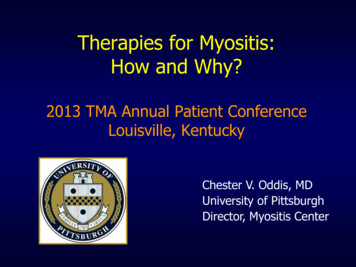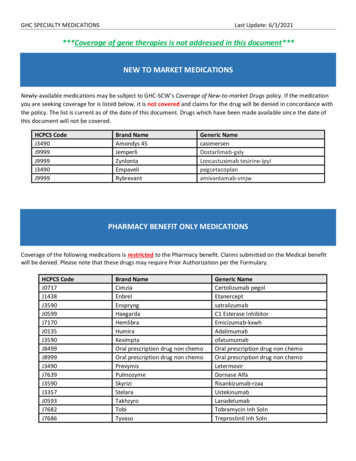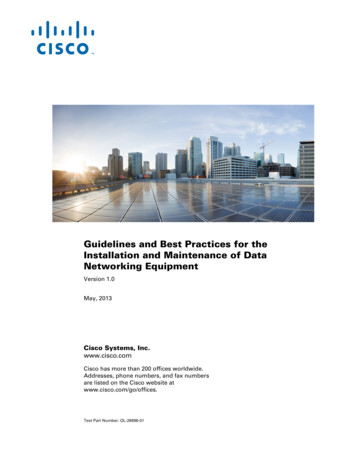
Transcription
Therapies for Myositis:How and Why?2013 TMA Annual Patient ConferenceLouisville, KentuckyChester V. Oddis, MDUniversity of PittsburghDirector, Myositis Center
DisclosuresQuestcor: Advisory Board
Overview How does your doctor decide how to treat you Simple decisions More complex decisions How does a newer drug make it on themyositis treatment scene?
Simple Decisions Most physicians choose glucocorticoids astheir initial treatment Methotrexate is often given next or evenconcomitantly with steroids Azathioprine may be given using samerationale
Rationale Behind the Simple Decisions Published studies Experience of the treating physician– Art Science Rheumatology vs. Neurology– Methotrexate: rheumatologist– Azathioprine: neurologist
Beyond Steroids Mtx Imuran Many physicians still struggle with thisin treating myositis patients
Beyond Steroids Mtx Imuran Many physicians still struggle with thisin treating myositis patients Including me and the “experts” thatyou‟ll meet over the next 2 days
Beyond Steroids Mtx Imuran Many physicians still struggle with thisin treating myositis patients Including me and the “experts” thatyou‟ll meet over the next 2 days Look at published studies
Aggarwal/Oddis, Curr Rheum Rep, 2012
Beyond Steroids Mtx Imuran Many physicians still struggle with thisin treating myositis patients Including me and the “experts” Look at published studies– Case series with very few „controlled‟ trials
Beyond Steroids Mtx Imuran Many physicians still struggle with thisin treating myositis patients Including me and the “experts” Look at published studies– Case series with very few „controlled‟ trials Experience with agents used for otherdiseases
General Concepts: Myositis Therapies Myositis is inflammatory and autoimmune
General Concepts: Myositis Therapies Myositis is inflammatory and autoimmune Drugs will:– Decrease inflammation (e.g. steroids)– Suppress the immune system
General Concepts: Myositis Therapies Myositis is inflammatory and autoimmune Drugs will:– Decrease inflammation (e.g. steroids)– Suppress the immune system Borrowed from oncologists– Methotrexate, imuran, cytoxan and rituximab
General Concepts: Myositis Therapies Myositis is inflammatory and autoimmune Drugs will:– Decrease inflammation (e.g. steroids)– Suppress the immune system Borrowed from oncologists– Methotrexate, imuran, cytoxan and rituximab Borrowed from transplant surgeons– Cyclosporine, tacrolimus, MMF (CellCept)
Rituximab in MyositisRIM TrialRituximab in the Treatment of Refractory Adult and JuvenileDermatomyositis (DM) and Adult Polymyositis (PM)
Summary: Published Trials in IIM (2003) 26 prospective myositis trials reviewed 14 adult PM-DM; 5 adult IBM; 5 JDM; 2 adultPM/DM/IBM
Summary: Published Trials in IIM (2003) 26 prospective myositis trials reviewed 14 adult PM-DM; 5 adult IBM; 5 JDM; 2 adultPM/DM/IBM Problems with trials different myositis classification criteria no uniformity with inclusion/exclusion criteria variability in therapies combined with drug beingstudied different intervals of assessment no uniformity in outcome measures
„Perfect Storm‟ for RIM Trial IMACS
IMACSInternational Myositis Assessment and Clinical Studies Group Coalition of health care providers withexperience and interest in the myositissyndromes Goal: Improve the lives of children and adultswith myositis Discovering better therapies by understanding thecauses of myositis
„Perfect Storm‟ for RIM Trial IMACS Adult/pediatric/multidisciplinary/international
„Perfect Storm‟ for RIM Trial IMACS eed upon outcome measures [Miller]
„Perfect Storm‟ for RIM Trial IMACS Adult/pediatric/multidisciplinary/international Agreed upon outcome measures [Miller] Definition(s) of improvement for myositistrials [Rider]
„Perfect Storm‟ for RIM Trial IMACS Adult/pediatric/multidisciplinary/international Agreed upon outcome measures [Miller] Definition(s) of improvement for myositistrials [Rider] Consensus on conducting myositis clinicaltrials [Oddis/Rider]
„Perfect Storm‟ for RIM Trial IMACS Adult/pediatric/multidisciplinary/international Agreed upon outcome measures [Miller] Definition(s) of improvement for myositistrials [Rider] Consensus on conducting myositis clinicaltrials [Oddis/Rider] Disease activity and damage measures[Sultan/Isenberg]
Why Use Rituximab inPolymyositis andDermatomyositis?
Why Use Rituximab inPolymyositis andDermatomyositis?Used over the past couple of years inmany different “autoimmune” diseases inboth adults and children withencouraging results
Rituximab in the Treatment ofDermatomyositis Open-label uncontrolled pilot trial in 7adult refractory DM patients 4 IV infusions of rituximab at weeklyintervalsLevine, Arth Rheum, 2005
„Perfect Storm‟ for RIM Trial IMACS Adult/pediatric/multidisciplinary/international Agreed upon outcome measures [Miller] Definition(s) of improvement for myositistrials [Rider] Consensus on conducting myositis clinicaltrials [Oddis/Rider] Disease activity and damage measures[Sultan/Isenberg]
RIM TrialFacilitated by:Supported by:Study PartnersIMACS
RIM TrialFacilitated by:IMACSSupported by:Study Partners 200 myositis patients: 76 adult PM ,76 adult DM and 48 JDM patients Patients were followed for 44 weeks Myositis Core Set Measures (CSM) were assessed monthly Patients met a pre-defined ‘Definition of Improvement’
Participating Centers
Foreign Centers
Participating CentersAdult Sites Alabama (Fessler) Boston (Narayanaswami) Czechoslovakia (Vencovsky) Dallas (Olsen) Kansas City (Barohn/Latinis) Kentucky (Crofford) London (Isenberg) Mayo Clinic (Ytterberg) Miami (Sharma) Michigan (Seibold/Schiopu) Michigan State (Martin/Eggebeen) Milwaukee (Cronin) New York: North Shore (Marder) New York: HSS (DiMartino) NIH (Miller) Philadelphia (Kolasinski) Phoenix (Levine) Pittsburgh (Oddis/Ascherman) Stanford (Chung/Fiorentino) Sweden (Lundberg) UCLA (Weisman/Venuturupalli)Pediatric Sites Boston (Kim) Cincinnati (Lovell) Duke (Rabinovich) Mayo Clinic (Reed) Miami (Rivas-Chacon) Michigan State (Martin/Eggebeen) NIH (Rider) Nova Scotia (Huber) Philadelphia (Sherry) Pittsburgh (Kietz) Stanford (Sandborg) Toronto (Feldman)
There are other ways tostudy or recommenddrugs for myositis
CARRA Approach: JDM(Childhood Arthritis and Rheumatology Alliance) Randomized controlled trials are difficult and expensive So sent survey to pediatric rheumatologists describingclinical JDM cases Questions:1.2.What other tests would your order?What medicines would you start? 84% of pediatric rheumatologists responded Guidelines on treatment and diagnosis published–––Steroid, methotrexate guidelinesConcern about biologicsMRI use (less EMG/muscle biopsy)Stringer; J Rheumatol; 2010
TMA Approach Inadequate classification criteria limits clinicalstudies TMA funded study to redefine criteria for myositis– International Myositis Classification Criteria Project(Dr. Ingrid Lundberg) Lot of data generated from many adult andpediatric rheumatologists around the world– Clinical features (muscle, skin, lung etc.)– Laboratory tests (enzymes, autoantibodies, etc.) Objective: develop and validate newerclassification criteria for adult/juvenile myositis
Taking Advantage of the IMCCP Go back to the doctors that contributed patient data tothe project Combine collected data with additional treatment data Identify patients with a „complete response‟– 6 months of no disease activity while on treatment Identify patients with „remission‟– Complete response without treatment for 6 months Goal: Determine the therapies that lead to „completeresponses‟ or „remission‟
Collaboration with Basic Scientists:The Value of Specimen Repositories Investigator determines a plausible mechanismfor immune dysfunction in myositis
Collaboration with Basic Scientists:The Value of Specimen Repositories Investigator determines a plausible mechanismfor immune dysfunction in myositis Type I Interferon (cytokine)– genes induced by IFN-I are „turned on‟– proteins are produced from these genes andmeasured and correlate with clinical disease activity
Collaboration with Basic Scientists:The Value of Specimen Repositories Investigator determines a plausible mechanismfor immune dysfunction in myositis Type I Interferon (cytokine)– genes induced by IFN-I are „turned on‟– proteins are produced from these genes andmeasured and correlate with clinical disease activity Go from „bench to bedside‟– Treat the patients and study their blood– Markers of activity dropped
These studies led to a trialtargeting Type I IFN
Summary and Future Directions There are many similar examples of cytokinesbeing studied and targeted (IL-6) Animal models can provide valuable plausibletargets of therapies Clinician has an idea and treats several patientsand publishes the data Stimulating research– Databases with longitudinal clinical data tied to aspecimen repository– Well thought out specimen collection tied to a clinicaltrial
(Dr. Ingrid Lundberg) Lot of data generated from many adult and pediatric rheumatologists around the world –Clinical features (muscle, skin, lung etc.) –Laboratory tests (enzymes, autoantibodies, etc.) Objective: develop and validate











